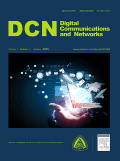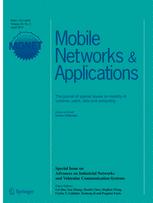10th International Conference on Communications and Networking in China - ChinaCom 2015 August 15th-17th, 2015 Shanghai, China
CALL FOR PAPERS
[Scope]
ChinaCom is endorsed by the European Alliance for Innovation (https://eai.eu/), a leading community-based organization devoted to the advancement of innovation in the field of ICT. The aim of ChinaCom is to bring together Chinese and international researchers and practitioners in networking and communications under one roof, building a showcase of these fields in China. ChinaCom is being positioned as the premier international annual conference for the presentation of original and fundamental research advances in the field of communications, networks, and internet applications. The conference will consist of technical symposia, panels, tutorials, and workshops. All submissions to this conference will be subject to rigorous peer review before included in the technical sessions.
[Submissions]
Please refer to https://chinacom.org/show/initial-submission for further information on submission format and requirements.
[Publication]
All accepted and presented papers will be included in the ChinaCom 2015 Conference Proceedings, and will be submitted for inclusion in IEEE Xplore and EI Compendex. Papers accepted and presented in ChinaCom 2006-2014 have been indexed by EI entirely. Selected best and outstanding papers will be considered for publication in special issues of SCI-indexed Journals MONET and SCN after further extension, as well as EAI Endorsed Transactions on Industrial Networks and Intelligent Systems, Digital Communications and Networks.
The proceedings are submitted for inclusion to the leading indexing services: DBLP, Google Scholar, Thomson Scientific ISI Proceedings, EI Elsevier Engineering Index, CrossRef, Scopus, as well as ICST's own EU Digital Library (EUDL).
We reserve the right to exclude papers accepted but not presented from the conference proceedings submitted for archiving and indexing.
[Important dates]
- Paper submission deadline:
April 30, 2015May 19, 2015 - Author notification: June 20, 2015
- Camera-ready: July 15, 2015
Wireless Communications and Networking
- Antennas, propagation and channel modeling
- Modulation, coding and diversity techniques
- Equalization, detection and estimation
- Multiple antenna and multicarrier technologies
- Multiple access techniques
- Wireless air interference and link control
- Multimedia communications and QoS
- Radio resource management and interference control
- Network architecture and planning
- Wireless ad hoc and mesh networks
- Vehicular networks
- Bluetooth technologies and applications
- Body area networks
- Heterogeneous networks and systems
- Ultra-wideband communications (UWB)
- Radio frequency identification (RFID)
- LTE, LTE-Advanced and 4G
- WLAN/WPAN and mobile Internet
- Wi-Fi and WiMAX
Optical Communications and Networking
- Optical network architecture, application, and services
- High speed, high spectral efficiency optical communication systems
- Optical switching technologies
- Backbone and metro-core networks
- Optical access network design and protocols
- Optical network survivability
- DWDM/CWDM transceivers and transponders
- Optical devices for switching, filtering, and Interconnects
- Optical communication performance monitoring
- Energy efficiency in optical networks
- Convergence of optical and wireless access networks
- Optical wireless communications
Information Theory Coding
- Coding theory and practice
- Communication theory
- Data compression
- Signal detection and estimation
- Information theory and statistics
- Network communication theory
- Multiple terminal information theory
- Quantum information theory
- Sequences and complexity
- Channel capacity
- Joint source and channel coding
Signal Processing for Communications
- Adaptive signal processing
- Multi-rate signal processing
- Array Signal Processing
- Blind Signal Processing
- Signal detection and synchronization
- SIMO, MISO, MIMO precoder/decoder design
- Smart antenna beamforming and DOA estimation
- Radar signal processing
- Distributed/centralized algorithms for communication systems
- Statistical signal processing
- Spectral analysis and estimation
- System level optimization
- Cross-layer optimization
- Software defined and cognitive radio
- Compressive sensing and compressive sampling
- Space-time processing and decoding
- Channel estimation, equalization and modeling
- Localization and positioning techniques
- Signal processing in LTE/LTE-A/IMT-A and other emerging systems
- Signal processing for security and cryptography
Network and Information Security
- Security in cloud and grid systems
- Network security analysis and prediction technologies
- Network risk analysis and evaluation technologies
- Trusted computing
- Cryptography and data security
- Multilevel security system and technologies
- Denial-of-service attacks and countermeasures
- Wireless and pervasive/ubiquitous computing security
- Security for critical infrastructures
- Intrusion and anomaly detection and prevention
- Automated tools for source code analysis
- Malicious code analysis, anti-virus, anti-spyware
- Privacy-preserving (and compromising) systems
- Security and privacy in network
Ad-hoc and Sensor Networks
- Access Control
- Ad Hoc networks of autonomous intelligent systems
- Analytic methods and modeling for performance evaluation
- Ad hoc network applications and architectures
- Delay-tolerant networking
- Distributed algorithms for ad hoc networks
- Geometric graphs
- Location discovery and management
- Mobile ad hoc computing platforms, systems and test beds
- Mobile social networking
- Quality-of-service
- Routing protocols (unicast, multicast, etc.)
- Sensor networks
- Self-configuration
- Service discovery
- Timing synchronization
Multimedia Communications & Smart Networking
- Multimedia delivery and streaming over wired and wireless networks
- Cross-layer optimization for multimedia services
- Multicast, broadcast and IPTV
- Multimedia computing systems and human-machine interaction
- Interactive media and immersive environments
- Multimedia content analysis and search
- Multimedia databases and digital libraries
- Converged application/communication servers
- Multimedia security and privacy
- Multimedia analysis and social media
- Multimedia QoS provisioning
- Multimedia streaming over mobile social networks and service overlay networks
- Service creation, delivery, management
- Virtual home environment and network management
- Charging, pricing, business models
- Cooperative networking for streaming media content
- Ubiquitous computing services and applications
- Networked autonomous systems
- Communications software or applications of autonomous behavior in vehicular communications
- Web services and distributed software technology
- Software for distributed systems and applications, including smart grid and cloud computing services
- Peer-to-peer technologies for communication services
- Context awareness and personalization
- Wearable computing architecture,protocol or applicaiton based on wireless sensor etworks and Ubiquitous Network
- Smart networking for social networks and collaborative systems
- Intelligent application software architecture for Internet of Things
Green Communications & Computing
- Green computing models, simulations, designs
- Energy-efficient networking and computing infrastructures
- Energy-aware resource allocation and scheduling mechanisms
- Green materials and devices design
- Usage of renewable energy for green ICT operation
- Cross-layer optimization of green networking infrastructures
- End-to-end modeling and performance of green communication networks
- Communication networks for smart grids
- Energy efficient hardware, devices and designs
- Life-cycle analysis of computing equipment
- Energy harvesting, storage, and recycling
- Climate and ecosystem monitoring
- Energy-efficient data center and cloud technologies
- Cooperative theory and game theory for green communication networks
- Green high-performance computing and applications
- Realization of smart grids by the application of ICT
- Integration of distributed energy resources
Communication Software and QoS
- Service Oriented Architectures, Service Portability
- SIP Based Services, Multimedia and Middleware
- Innovative User Interfaces for Multimedia Services
- Regulations, Standards and Spectrum Management
- Communications Software and Services
- Mobile Computing Systems
- Service-based Grid/Cloud/Autonomic Computing
- Services Computing in Mobile Ad-hoc NETworks (MANETs)
- Service Level Agreements (SLAs) Negotiation, Automation and Orchestration
- QoS/SLA in sensor networks
- Provisioning of QoS in terms of bandwidth and delay assurance
- System services and distributed services in sensor networks
- Quality of Services (QoS) and Cost of Services (CoS)
- Ontology and Semantic Web for Services Computing
- Services Repository and Registry
- Formal Methods for SOA
- Service Discovery
- Services Engineering Practices and Case Studies
Machine2Machine
- Machine-to-machine (M2M) communications
- Applications such as industrial automation, logistics, Smart Grid, Smart Cities, health, defence etc.
- Internet of Things (IoT)
- Internet Protocol Version 6 (IPv6)
- Telematics applications
- Transport protocol suitable for communication in M2M/IoT
- Smart cities/municipalities
- M2M Applications












































